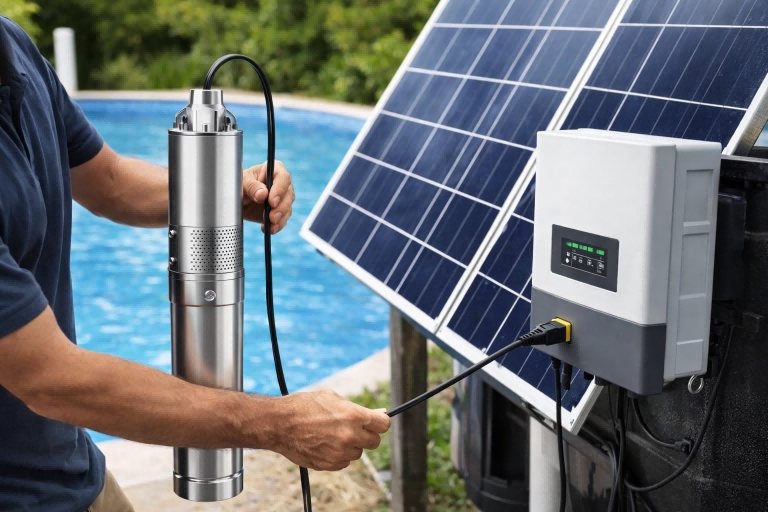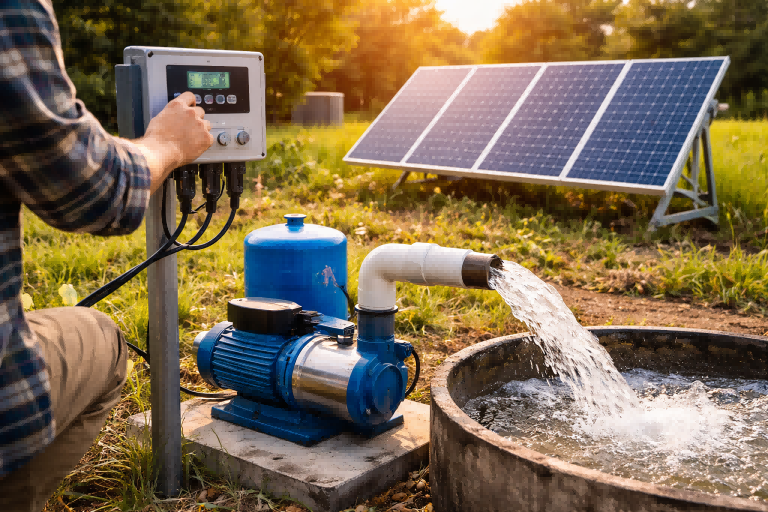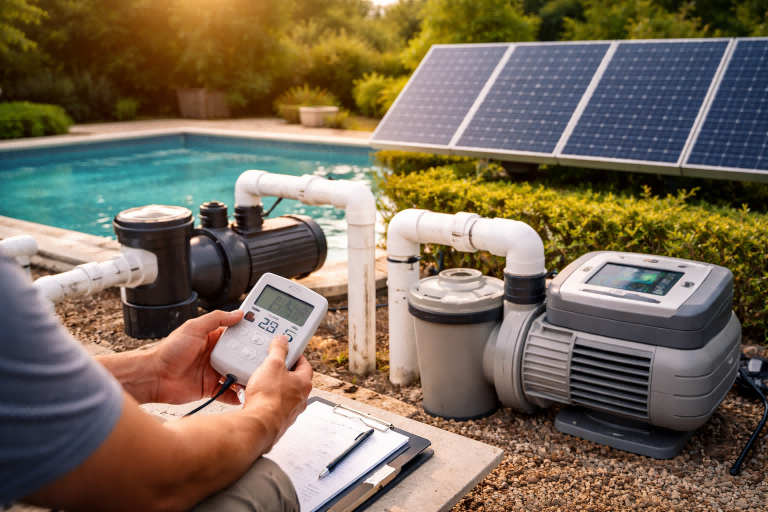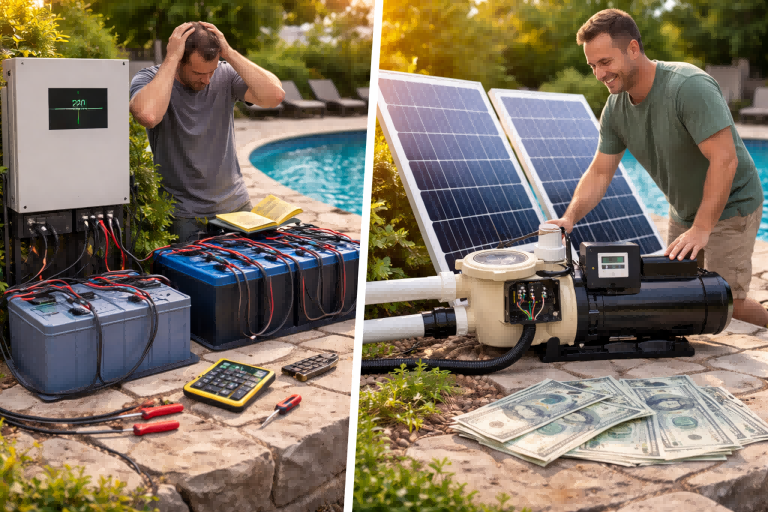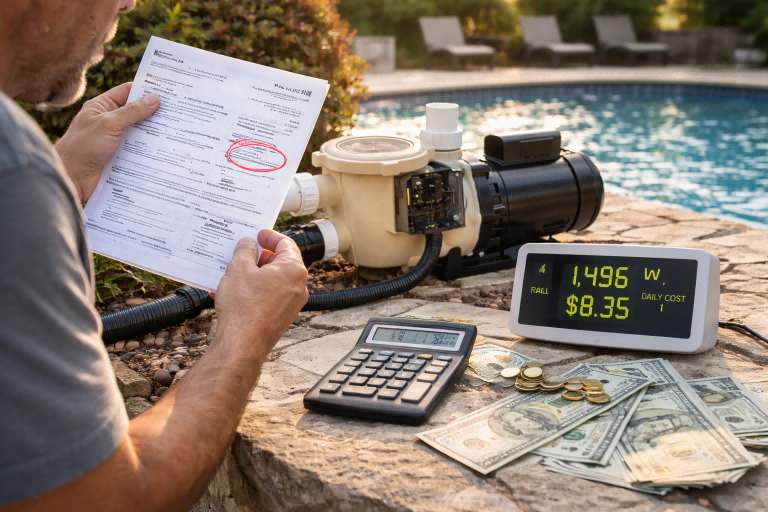Struggling with weak showers and slow-filling appliances?
Low water pressure can be a daily frustration, but a booster pump is the perfect solution to fix it.
A water pressure booster pump should be installed on the main water line after the water meter and main shut-off valve.
This placement ensures it boosts pressure for the entire property.
The location must be dry, accessible for maintenance, and have a nearby electrical outlet.
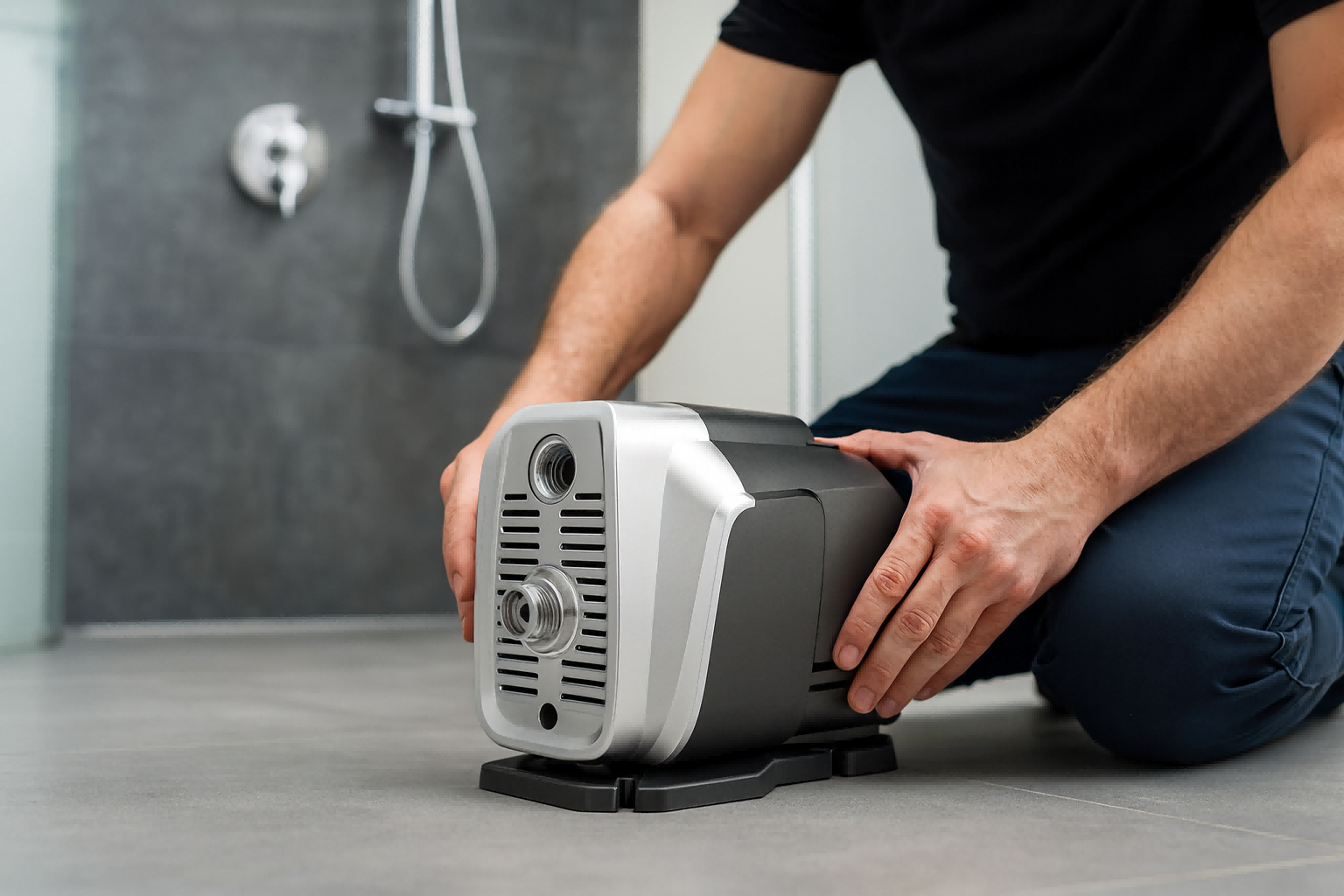
Choosing the right installation spot is the first critical step toward solving your water pressure problems.
However, understanding what makes a modern pump the right choice is just as important for long-term satisfaction and efficiency.
The technology inside these pumps determines how well they perform, how much energy they save, and how long they last.
Let's explore the key features you should look for and how they impact the pump's ideal placement and overall function.
What Makes Modern Booster Pumps So Efficient?
Tired of fluctuating water flow and high energy bills?
A traditional pump runs at full speed, wasting power, but modern pumps offer a smarter, more efficient solution.
**Modern booster pumps use a Variable Frequency Drive (VFD) and a Permanent Magnet Synchronous Motor (PMSM).
This technology allows the pump to adjust its speed in real-time.
It provides constant pressure while cutting energy use, delivering both performance and savings.**
The core of a modern booster pump's superiority lies in its advanced drive technology.
This isn't just about spinning an impeller; it's about intelligent control that adapts to your home's needs.
The combination of a VFD with a high-efficiency PMSM is what separates a basic pump from a sophisticated water pressure management system.
This pairing is engineered to solve the most common complaints associated with older pump technologies.
The Power of VFD and PMSM
A VFD acts as the pump's brain.
It constantly monitors system pressure.
When you open a tap, the VFD senses the pressure drop and tells the motor to speed up just enough to meet the demand.
When you close the tap, it slows the motor down.
This is fundamentally different from older pumps that slam on at full power and then shut off completely.
The PMSM is the heart of this system.
These motors are significantly more efficient than traditional induction motors.
They use powerful magnets, which reduces electrical losses and allows for more precise speed control.
This synergy results in several key benefits for the user.
Key Performance Benefits
The soft start and soft stop function is a major advantage.
The pump gradually accelerates and decelerates.
This gentle operation reduces the sudden jolt on your pipes, a phenomenon known as water hammer.
Eliminating water hammer protects your plumbing system from long-term stress and potential leaks.
Another benefit is quiet operation.
The precise control and efficient motor design lead to noise levels below 50 decibels.
This means you can install the pump without it becoming a noisy nuisance in your home.
Finally, you get wide pressure customization.
Users can set the desired output pressure very precisely.
The system will then maintain that exact pressure, whether one faucet is running or several are.
| Feature | Traditional Pump | Modern VFD Pump |
|---|---|---|
| Operation | On/Off at full speed | Variable speed, demand-based |
| Pressure | Fluctuates | Constant and stable |
| Noise Level | Loud | Very quiet (≤50dB) |
| Energy Use | High | Significantly lower |
| Pipe Stress | High (Water Hammer) | Low (Soft Start/Stop) |
How Are High-End Pumps Built to Last?
Worried that a new pump will fail after just a few years?
Many pumps use basic materials and offer limited protection, leading to premature breakdowns and costly replacements.
**High-end pumps are built for longevity with premium materials like stainless steel impellers and advanced cooling systems.
They feature robust internal components, such as high-grade bearings and superior motor insulation, ensuring they withstand years of demanding operation.**
The true value of a booster pump is measured not just in its performance but in its service life.
A pump is an investment, and its durability depends entirely on the quality of its construction, from the large housing to the smallest internal part.
Manufacturers of top-tier pumps focus on an engineering philosophy that prioritizes resilience and reliability.
This means carefully selecting every component for its ability to resist wear, corrosion, and heat, which are the primary enemies of any pump system.
Advanced Mechanical and Material Engineering
The internal components are where quality truly matters.
The pump's impeller is the part that actually moves the water.
Using a material like AISI304 stainless steel is crucial.
This grade of stainless steel offers excellent resistance to corrosion and rust, ensuring the pump's hydraulic performance doesn't degrade over time, even with varying water quality.
The motor's stator design is another critical area.
Advanced designs use high-grade silicon steel to improve magnetic efficiency and reduce energy loss as heat.
This leads to a lower temperature rise during operation.
A cooler motor is a longer-lasting motor.
This is further enhanced by using Class F insulation wire for the motor windings, which can withstand high temperatures without degrading.
The Importance of Premium Components
Even seemingly small parts like bearings have a huge impact.
Using high-precision bearings from respected manufacturers like NSK or C&U makes a significant difference.
These bearings operate more quietly, with less friction, and are designed for a much longer lifespan compared to standard, generic bearings.
The motor's rotor often uses advanced ferrite magnets.
These magnets maintain their strength even at high temperatures (up to 150°C), ensuring the motor's performance remains consistent and reliable throughout its life.
Some models also include optional configurations for electromagnetic compatibility (EMC) and power factor correction (PFC) to meet strict international electrical standards.
Superior Cooling Systems
Heat is a motor's worst enemy.
An effective cooling system is non-negotiable for a durable pump.
Well-designed pumps feature an optimized fan and housing.
This design improves airflow across the motor's surface.
An efficient cooling system can dissipate heat far more effectively.
This keeps the motor operating within its ideal temperature range, directly contributing to a longer, more reliable service life.
Can a Pump Protect Itself from Damage?
Concerned that electrical issues or a water shortage could destroy your pump?
Common problems like dry running, power surges, or overheating can cause irreversible damage to standard pumps.
**Yes, intelligent pumps can protect themselves.
They are equipped with a comprehensive suite of up to 14 built-in safety functions.
These systems actively monitor for issues like dry running, voltage spikes, overheating, and freezing, automatically shutting down or adjusting to prevent damage.**
The intelligence of a modern booster pump is most evident in its self-preservation capabilities.
A truly smart pump doesn't just move water; it actively manages its own health and safety.
This is achieved through a sophisticated electronic control unit that acts as a vigilant guardian.
This controller is programmed to recognize a wide array of potentially harmful conditions.
It can then take immediate, autonomous action to protect the motor, the electronics, and the pump's mechanical components from harm, ensuring reliability and a long service life.
The UltraShield for Electronics
The pump's main controller board, or PCB, is its brain.
It is also the component most vulnerable to environmental factors like moisture and dust.
A standout feature in top-tier pumps is a fully potted PCB.
Potting means the entire circuit board is encased in a solid block of protective resin.
This process provides several critical benefits:
- Total Waterproofing: It creates an impenetrable IP67-rated seal, making the electronics completely immune to moisture, condensation, humidity, and dust. This is vital, since pumps are often installed in damp environments like basements or utility closets.
- Vibration Damping: The solid resin helps absorb vibrations, protecting delicate solder joints and electronic components from mechanical stress.
- Extended Lifespan: By isolating the electronics from the harsh operating environment, this potting technique can extend the controller's life by several years, preventing the most common cause of electronic failure.
A Full Suite of Safety Functions
Beyond a protected PCB, the pump's software includes a multi-layered safety system.
This system monitors a range of operational parameters in real-time.
| Protection Category | Specific Safeguards | Purpose |
|---|---|---|
| Electrical Protections | Input Over/Under Voltage, Overcurrent, Phase Loss, Stall Protection | Guards against unstable or faulty power supply that can burn out a motor. |
| Thermal Protections | Driver Board Overheating, High Water Temperature, Short-time Overheating | Prevents damage from excessive heat, whether from the electronics or the water itself. |
| System Protections | Dry Run Protection, Antifreeze Protection, Pipeline Leak Warning | Protects against common system-level issues like lack of water, freezing, or leaks. |
| Sensor Protections | Sensor Failure Warnings (Pressure, Temperature) | Allows the system to self-diagnose and alert the user to a faulty sensor. |
The dry run protection is particularly intelligent.
If it detects no water, it doesn't just shut off.
It initiates a smart recovery algorithm, attempting to re-prime itself at set intervals before going into longer sleep modes to conserve energy.
How Do You Control and Monitor a Smart Pump?
Are you worried that a high-tech pump will be too complicated to use?
Many advanced devices have confusing interfaces, making simple adjustments and monitoring a frustrating chore.
**You can easily control and monitor a smart pump through its intuitive onboard interface with simple buttons and clear LED indicators.
Many models also offer optional Wi-Fi connectivity, allowing for real-time monitoring and pressure adjustments directly from your smartphone.**
Despite the complex technology working inside, a modern booster pump is designed for simple, user-friendly operation.
The goal is to provide powerful control without a steep learning curve.
Engineers achieve this by focusing on an intuitive user interface that gives you all the essential information and control you need at a glance.
This combination of straightforward onboard controls and optional advanced remote monitoring ensures that anyone can manage their water pressure system with confidence, from homeowners to maintenance professionals.
Simple On-Pump Controls
The physical interface on the pump itself is designed for clarity.
Typically, it features a small set of buttons and a series of LED lights.
This setup allows for effortless daily operation.
- Basic Functions: A single press of the power button turns the pump on or off. Two other buttons, "UP" and "DOWN," allow you to increase or decrease the target water pressure in small, precise increments.
- Factory Reset: A simple long press of the power button can restore the pump to its original default settings if needed.
The LED indicators provide immediate visual feedback.
You can instantly see if the pump is running in constant pressure mode, if a pipeline leak has been detected, if there's a water shortage, or if there is an issue with the input voltage.
Some displays also show the pump's current power output level at a glance.
Deep Dive into Real-Time Data
For users who want more insight, the system offers an easy way to access detailed operational data.
A long press of a mode or function button typically cycles the main display through several key real-time metrics.
This feature turns the simple display into a powerful diagnostic tool, showing you exactly what the pump is doing at any moment.
Here's the kind of information you can access:
- A.xx: Current water temperature being pumped.
- P.xxx: Real-time power consumption in watts.
- xxxx: The motor's current speed in revolutions per minute (RPM).
- U.xxx: Live input voltage from your power supply.
- t.xx: The temperature of the main printed circuit board (PCB).
- Recovery Pressure: Displays the pressure at which the pump will restart.
This level of transparency is invaluable for monitoring the pump's health and efficiency.
It can also help diagnose potential issues with your plumbing or electrical systems.
For example, seeing a consistently high power draw (P.xxx) could indicate a major leak somewhere in your home.
Conclusion
Choosing where to install a booster pump is the first step.
Understanding the technology that ensures efficiency, durability, and safety is key to making a truly smart investment for your property.
FAQs
Where should a booster pump be placed?
A booster pump should be installed on the main water line after the meter.
It needs to be in a dry, accessible location near a power source.
Do I need a check valve before my booster pump?
Yes, a check valve before the pump is recommended.
It prevents water from flowing backward and protects the pump from backpressure.
How do I choose a water booster pump?
Consider your flow rate and pressure needs.
Look for features like VFD technology for efficiency and robust safety protections for durability.
Can a booster pump be installed outside?
Yes, but it must be protected from direct rain, sun, and freezing temperatures.
Placing it in a weatherproof, insulated enclosure is best.
Should a booster pump run continuously?
No, a modern VFD booster pump should only run when there is water demand.
It automatically adjusts its speed and enters standby when not needed.
Is a pressure tank necessary with a booster pump?
A small pressure tank is highly recommended.
It reduces pump cycling for small water uses and prevents water hammer, extending pump life.
How much pressure can a booster pump add?
This varies by model.
Most residential booster pumps can add between 20 to 60 PSI to your existing water pressure.
What size booster pump do I need for my house?
The size depends on the number of fixtures and your GPM (gallons per minute) demand.
A plumber can help calculate the exact size you need.


